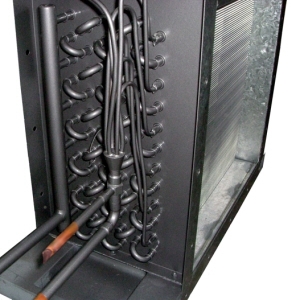EVAPORATING AND CONDENSING COILS TO SUIT ALL COMMON REFRIGERANTS
Reducing the temperature of air flows to a level below the ambient temperature requires a coil charged with refrigerants. SPC's range of evaporating and condensing coils suit all the common refrigerants.
We have over 20 years' experience in the design and manufacture of coils. There are few, if any, design and specification issues that we have not addressed before. When you specify a coil from SPC, you're sourcing it from the coil experts.
Efficient extractors of heat energy
A refrigerant coil is a heat exchanger. It extracts heat energy from a stream of air and passes it to the refrigerant within the coil as quickly and efficiently as possible.
Cooling systems that rely on refrigerants require a linked pair of evaporating (or DX - for Direct eXpansion) and condensing units. As the refrigerant passes between them, it alteates between vapour and liquid phases in a continuous cycle.
The evaporating (DX coil) phase does the cooling. The latent heat of vaporisation is the term used to describe the energy that the refrigerant needs to change from the liquid to the vapour state.
Refrigerant vapour then passes to the condensing coil. Here it gives up its energy and retus to the liquid state before flowing back to the DX coil.
The coils themselves consist of a matrix of copper tubes through which the refrigerant liquid/vapour flows. The tubes run back and forth between two end-plates in an arrangement that lets the air flow perpendicular to the tubes. The tubes pass through - and are attached to - a layered array of thin metal plates known as fins. The fins are also perpendicular to the tubes, which means they lie parallel to the direction of air flow.
The efficiency of this arrangement depends on the types and thickness of metal used, the integrity of the bond between tubes and fins, and the number and the layout of the tubes and fins. A crucial aspect of DX coil design is arranging tube lengths and bends to create identical flows through parallel coil circuits. Unequal flows will damage the system. Our skill lies in pulling all those elements together to make a coil that's right for your application.
Types of DX (evaporator) coil
Sometimes two or more compressors feed refrigerant into a single coil. Each tube circuit is separate and can be switched on or off to increase or decrease the duty of the coil. The various coil circuits fed by each compressor can be arranged in two ways:
Interlaced coils are the more common. Alteate circuits relate to different compressors.
Split-in-face coils have upper circuits from one compressor, lower circuits from another.
Another method of varying coil duty is to inject gas directly into the coil unit.
Hot gas bypass coils admit variable amounts of compressed refrigerant vapour (at a high temperature and pressure) into the coil - the more gas the lower the duty because less liquid refrigerant can evaporate.

Refrigerant Coils

